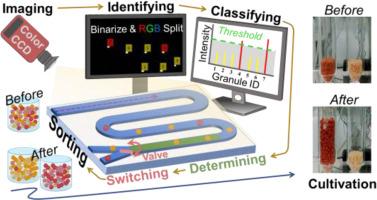高活性厌氧氨氧化颗粒的计算机视觉辅助分选与选择性培养
IF 12.4
1区 环境科学与生态学
Q1 ENGINEERING, ENVIRONMENTAL
引用次数: 0
摘要
厌氧氨氧化(anammox)颗粒污泥是一项发展迅速的生物废水处理技术,具有脱氮效率高的特点,目前正处于工程应用和工艺优化阶段。实验室和全面的观察一致表明,厌氧氨氧化污泥由具有不同颜色变化的颗粒组成,通常从黄色到红色不等。我们之前的研究表明,红色颗粒在单颗粒水平上表现出明显更高的生化活性。基于这一见解,本研究介绍了一种计算机视觉辅助的流体分选技术,能够从异质污泥群中选择性地分离红色颗粒。与未分选的颗粒相比,分选颗粒的扩展培养显示出更好的脱氮性能和生物量增殖。此外,红色颗粒富集反应器表现出增强的生物稳定性,随着时间的推移保持甚至改善代谢活性。该方法不仅加速了厌氧氨氧化系统的驯化、富集和启动,而且为推进环境生物技术的高速率和可持续脱氮提供了可扩展的策略。本文章由计算机程序翻译,如有差异,请以英文原文为准。

Computer vision-assisted sorting and selective cultivation of high-activity anammox granules
Anaerobic ammonium oxidation (anammox) granular sludge is a rapidly developing biological wastewater treatment technology characterized by high nitrogen removal efficiency, and now is being at the stage of engineering application and process optimization. Both laboratory and full-scale observations have consistently shown that anammox sludge comprises granules with distinct color variations, typically ranging from yellow to red. Our previous study demonstrated that red-colored granules exhibit significantly higher biochemical activity at the single-granule level. Building upon this insight, the present study introduces a computer vision-assisted fluidic sorting technique capable of selectively separating red granules from heterogeneous sludge populations. Extended cultivation of the sorted granules revealed superior nitrogen removal performance and biomass proliferation compared to unsorted granules. In addition, the red granule-enriched reactor demonstrated enhanced biological stability, maintaining and even improving metabolic activity over time. This approach not only accelerates the acclimation, enrichment, and startup of anammox systems but also provides a scalable strategy for advancing high-rate and sustainable nitrogen removal in environmental biotechnology.
求助全文
通过发布文献求助,成功后即可免费获取论文全文。
去求助
来源期刊

Water Research
环境科学-工程:环境
CiteScore
20.80
自引率
9.40%
发文量
1307
审稿时长
38 days
期刊介绍:
Water Research, along with its open access companion journal Water Research X, serves as a platform for publishing original research papers covering various aspects of the science and technology related to the anthropogenic water cycle, water quality, and its management worldwide. The audience targeted by the journal comprises biologists, chemical engineers, chemists, civil engineers, environmental engineers, limnologists, and microbiologists. The scope of the journal include:
•Treatment processes for water and wastewaters (municipal, agricultural, industrial, and on-site treatment), including resource recovery and residuals management;
•Urban hydrology including sewer systems, stormwater management, and green infrastructure;
•Drinking water treatment and distribution;
•Potable and non-potable water reuse;
•Sanitation, public health, and risk assessment;
•Anaerobic digestion, solid and hazardous waste management, including source characterization and the effects and control of leachates and gaseous emissions;
•Contaminants (chemical, microbial, anthropogenic particles such as nanoparticles or microplastics) and related water quality sensing, monitoring, fate, and assessment;
•Anthropogenic impacts on inland, tidal, coastal and urban waters, focusing on surface and ground waters, and point and non-point sources of pollution;
•Environmental restoration, linked to surface water, groundwater and groundwater remediation;
•Analysis of the interfaces between sediments and water, and between water and atmosphere, focusing specifically on anthropogenic impacts;
•Mathematical modelling, systems analysis, machine learning, and beneficial use of big data related to the anthropogenic water cycle;
•Socio-economic, policy, and regulations studies.
 求助内容:
求助内容: 应助结果提醒方式:
应助结果提醒方式:


